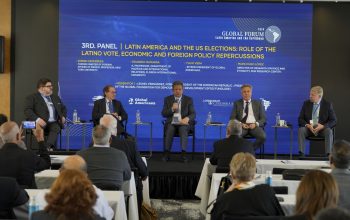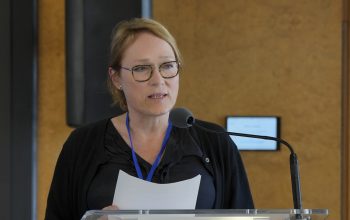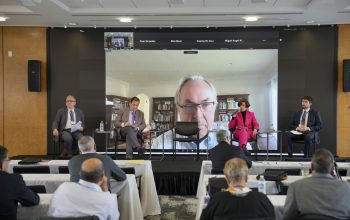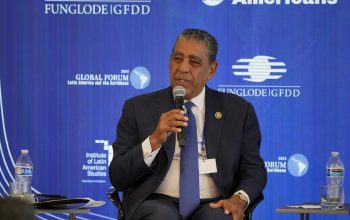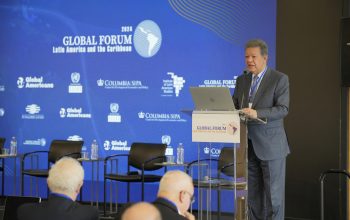news
“The Party System: Democracy and Popular Hegemony”, an article by Dr. Leonel Fernández
March 23, 2015
In addition to having won the last five consecutive elections—three presidential and two congressional and municipal—with more than 50% of the votes cast, the Dominican Liberation Party (PLD) currently appears in various polls with support above 70%.
Why is this happening? What reasons explain how founder Juan Bosch’s purple party of the yellow star should have become, since the end of the 20th century and well into the first decades of the 21st,
the foremost political power in the Dominican Republic?
The questions gain relevance when we remember that this was not always the case. When the PLD first participated in an electoral contest, in 1978, it garnered just 18,000 votes, equivalent to 1%, obligating it to re-gather signatures to recover its legal status.
This also contrasts with the fact that over four decades the political forces with the greatest impact in national politics were the
Dominican Revolutionary Party (PRD) and the Christian Social Reformist Party (PRSC).
To understand, then, the way in which the political pendulum has swung in the Dominican Republic over this historical cycle, we should turn our attention to what happened in the country in the period immediately following the execution of the tyrant Rafael Leónidas Trujillo in 1961.
And indeed, what happened was a large and tortuous process of transition to democracy
that, despite some moments of interruption, represented at all times a struggle to win ourselves freedom, democracy, and social justice.
At the start that struggle consisted of the de-Trujillanization of the country, that is, in getting rid of the cronies and remnants of that long dictatorship. Shortly thereafter, it involved organizing elections to choose a government put together by the will of the people.
The origins of PRD
predominance
It was based on this inaugural electoral process, in 1962, that an idea began to be built in the collective social imagination of the Dominican people of the Dominican Revolutionary Party as an engine or hegemonic organization in the defense of the national and popular wellbeing.
The basic reason for this phenomenon was its central figure: professor Juan Bosch, who in those elections achieved a smashing victory against the National Civic
Union, made up of the most conservative segments of the period.
While in those days the Civic Unionists and their leader, Dr. Viriato Fiallo, framed the debate in Trujillist or anti-Trujillist terms, Bosch, with his long political experience garnered over nearly a quarter-century in exile, oriented his discussion around what he defined as a struggle between the tutumpotes (people with money) and the hijos de machepa (sons of Chepita
Perez, mother of Dominican national hero and activist Juan Isidro Pérez).
By framing it in this way, professor Bosch introduced social issues as a dominant theme in national political debates for the first time, and oriented his entire program toward how to improve the living conditions of the Dominican people, especially among the lowest classes.
During his administration, Bosch introduced important institutional and social reforms in the country. As a
result, he and his party, the PRD, sparked enormous popular support and immense hopes among those traditionally excluded from the interests of politicians.
Unfortunately, Bosch’s administration lasted just 7 months. After the coup d’état of September 1963 and the rise of the Triumvirate government, many leaders and followers of the PRD were persecuted and imprisoned.
Then came the April Revolution of 1965, aiming to reestablish the
Bosch government and restore the Constitution of 1963. But U.S. military intervention, ordered by president Lyndon B. Johnson, to avoid a presumed “second Cuba” during the Cold War, halted it.
Throughout all these events, the PRD played a leading role, cementing a political, ideological, organizational, and even emotional relationship with varios layers of Dominican society.
During the 12-year period under Dr. Joaquín Balaguer, from
1966 to 1978, the Dominican Revolutionary Party once more played a central role—now not just through professor Juan Bosch but also through another charismatic figure, Dr. José Francisco Peña Gómez—in the resistance against that regime that over much of its duration had an eminently repressive character.
With the triumph of Antonio Guzmán in the 1978 elections, the PRD put an end to an era in the struggle for democracy by achieving the alternation of political power, but
at the same time began a new chapter in the nation’s story in which the decisive factor would no longer be the struggle for public freedoms, but for economic development, prosperity, and social wellbeing.
Weakening, decline, and emergence
Over the examined period, Dr. Joaquin Balaguer and the Christian Social Reformist Party had built up the fundamental basis of power. Over his 12 years in government, they managed to consolidate a
structure of military, business, middle-class urban, disaffected, and rural supporters.
Their power lay in the fact that during his mandate a relative political stability and certain order were achieved that had been lost during the chaos surrounding the unmooring of Trujillist authoritarianism, the toppling of Juan Bosch, and the April Revolution.
In addition, the reformist influence was cemented in the economic growth achieved and the development of
infrastructure projects throughout the entire national territory.
Although Dr. Balaguer would return to power for another 10 years, from 1986 to 1996, as he left no political heir, his physical disappearance led to a gradual process of weakening of the PRSC.
With regards to the PRD, while it’s true that Antonio Guzmán, with the freeing of political prisoners, return of exiles, and respect for human rights, contributed to the advance of democracy,
the same did not occur in the social and economic realms.
In that sense, his administration was a failure, as were the successive PRD governments of Salvador Jorge Blanco, from 1982 to 1986, and Hipólito Mejía, from 2000 to 2004.
During the latter two administrations the annual economic growth rate was scarcely 2.1%. Unemployment shot up, and the Dominican peso lost much of its value. Inflation increased, and in general the Dominican population experienced a
deep social unease, as was made clear in the protests of April 1984.
Prominent U.S. political scientist Jonathan Hartlyn has commented on this recent phase in our history:
“The history of the fight for political democracy in the Dominican Republic during the period 1978–1996 shows numerous disappointments … . There were reasons to be optimistic that the transition of 1978 would lead to a period of political change [or] democratic consolidation. These
reasons include social changes, the spectacular weakening of the Dominican military, and the affirmations of PRD leaders. Nonetheless, the period from 1978 to 1986, when the PRD held the presidency, should be seen as a missed opportunity…” [Translation from Spanish]
From 1996, with the ascent to power of the Dominican Liberation Party, another stage began in the Dominican Republic’s democratic transition.
On this occasion, a new
generation of politicians had the opportunity to combine economic and social development with advances in the democratic institutional order—and the PRD let the moment slip.
Despite the acid criticisms that their opponents might sling, it remains true that in general terms, the PLD achieved these objectives. During their periods of governance, the PLD has strengthened democratic institutions, among other factors, with the broadest constitutional reform seen in the country
since 1963; with the financial and administrative reform of the state; with the improvement in quality of public services; and with the reform and modernization of the judicial branch.
Likewise, PLD administrations have seen an average annual growth rate of over 7%, leading to a tripling in GDP from $20 billion to more than $60 billion.
This multiplication in the capacity for productivity generation, alongside policies aimed at increasing social
investment, have allowed poverty reductions, job creation, an expansion of the middle class, and an increase in affiliations with social security and subsidies aimed at the most vulnerable sectors of the population.
Having achieved these objectives where others have failed, the PLD has become the principal political force in the country over the past 20 years, and this is what explains its electoral success and current popular predominance in the national political
arena.
Related Links:
http://leonelfernandez.com/articulos/sistema-de-partidos-democracia-y-hegemonia-popular/

